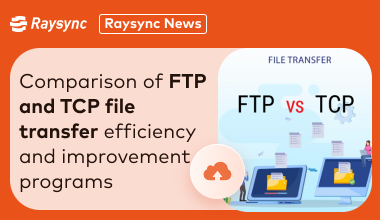The Best Way for Long Distance File Transfer
August 10, 2021When companies are transferring files over long distances, when they choose traditional FTP, network disks, etc. to transfer large files, in addition to slow speed, they often encounter transmission errors, transmission interruptions, and resuming transmissions. Although the traditional FTP transfer method supports the batch transfer of folders, when the number of files is large, in addition to the very slow speed, there are often problems such as missing files, file content errors, and inconsistent file numbers.

When the file capacity increases and the network environment becomes worse, the efficiency of file transfer and data exchange is low, and the security is poor. If the file is larger, usually a lower method such as express hard disk is used, which cannot meet the requirements of enterprises to obtain files on time. Seriously affect the overall operating efficiency of the enterprise.
This type of data transfer requires the use of data transfer protocols to ensure efficient and rapid transfer on high-speed networks. Several new data transfer protocols based on TCP or UDP have been introduced, and some comparative analysis and research have been carried out on such protocols.
There are currently several data transfer protocols and congestion control mechanisms GridFTP, FASP, QUIC, BBR, and LEDBAT, which are potential candidates for comparison in various scenarios. These protocols are designed to make fair use of available bandwidth among competing streams and provide reduced packet loss, reduced delay, and fast data transmission. In this paper, the behavior and performance of the data transfer protocol in various scenarios are explained.
These scenarios include transfers with various file sizes, multiple streams, background, and competing for traffic. The results show that FASP and GridFTP have the best performance among all protocols in most scenarios, especially for long-distance transfer with a large bandwidth-delay product (BDP). Due to the nature of its current implementation, QUIC has the lowest performance, which limits the size of the transmitted data and the bandwidth used. TCP BBR performs well in short-distance scenarios, but its performance decreases as the distance increases. The performance of LEDBAT cannot be predicted, so a complete evaluation cannot be performed. Comparing the performance of the protocol with background traffic and competing traffic shows that, except for FASP, most protocols are fair and radical. In addition, QUIC and FASP, which have the highest CPU utilization, are used to measure the resource utilization of each protocol on the sender and receiver. The performance of LEDBAT cannot be predicted, so a complete evaluation cannot be performed. Comparing the performance of the protocol with background traffic and competing traffic shows that, except for FASP, most protocols are fair and radical.
In addition, QUIC and FASP, which have the highest CPU utilization, are used to measure the resource utilization of each protocol on the sender and receiver. The performance of LEDBAT cannot be predicted, so a complete evaluation cannot be performed. Comparing the performance of the protocol with background traffic and competing traffic shows that, except for FASP, most protocols are fair and radical. In addition, QUIC and FASP, which have the highest CPU utilization, are used to measure the resource utilization of each protocol on the sender and receiver.
As a professional large file transfer system, RaySync supports high-speed file transfer, point to point transfer, and file synchronization services. The website provides a free download version, which includes 100GB download traffic, UDP transmission up to 200Mbps, TCP transmission wireless, and the server supports up to 3 simultaneous access users. The user needs to download a client, and the Raysync server needs to activate the license to experience the maximum speed. If it is not activated, the default is 5Mbps bandwidth. You can send any type of file until 100GB is used up, there is no time limit. Raysync transfer software is well optimized for long-distance and transnational transfer. If it needs to be transmitted from domestic to overseas, its transfer speed is the same as the domestic transfer.
For small and medium enterprises, Raysync also has a corresponding package: Raysync SMB, which only costs $1,599/year with up to 50 user accounts, and each user account can be as low as $11.98/year.
Enjoy the fast and secure file transfer experience with Raysync now!
You might also like

Raysync News
July 8, 2022Raysync has been focusing on providing high-speed file transfer solutions for enterprises since its establishment.

Raysync News
December 29, 2022Today is the day! Raysync's 100-day program has fully launched. Raysync has introduced a special offer for all of you who have the file transfer needs. Apply now and you 'll get a 100-day free trial of Raysync Pro (3TB transfer volume) that worths $820.

Raysync News
January 18, 2024In this article, we will explore two common file transfer protocols: FTP and TCP, analyze their efficiencies, and propose how Raysync technology can improve file transfer efficiency.